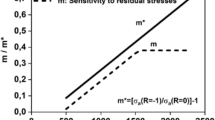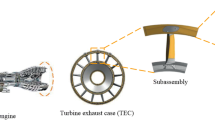The assessment of optimum surface hardening parameters of stress concentrator-bearing components is examined. Mechanics and mathematical model approaches were used to set the variational statement of the problem to find such a nonlocal (gradient) distribution of mechanical properties in the surface layers of components with stress concentrators that would improve the serviceability of structures as a whole. The functional was chosen as the optimality criterion that describes the contact strength of the structure and can assess the impact of strength parameters and stress concentrator characteristics on the product performance. The problem was solved with a free FEniCS finite element analysis package in Python. For a computer-processable software package, the algorithm is offered to evaluate the stress-strain state of a body with stress concentrators in contact interaction. The applied two-dimensional problem to assess the performance parameters of plasma-hardened locomotive tires with elliptic stress concentrators in view of their geometry is considered. A set of numerical experiments demonstrated that the geometric concentrator characteristics had a much greater impact on the product reliability than the size of such a defect. The concentrator radii ratio effect on the contact strength of a wheel tire was established. Elliptic concentrators with a major axis radii ratio greater than 40 were found to be most dangerous since just in the vicinity of their vertices, the stress state exhibits the worst performance parameters. Practical recommendations were advanced as regards the modified plasma-hardened layer depth to ensure adequate reliability of the rolling surfaces of railway wheels with an examined type of stress concentrators.



Similar content being viewed by others
References
Strength of Metals and Structures: Series of monographs, Vol. 2: Fatigue of Metals. Effect of the Surface Condition and Contact Interaction [in Russian], Pisarenko Institute of Problems of Strength, National Academy of Sciences of Ukraine, Kiev (2009).
S. P. Timoshenko, Statistical and Dynamic Problems of the Theory of Elasticity [in Russian], Naukova Dumka, Kiev (1975).
G. N. Savin, Stress Concentration near Holes [in Russian], Gostekhizdat, Moscow (1951).
G. N. Savin, Distribution of Stresses near Holes [in Russian], Naukova Dumka, Kyiv (1968).
G. N. Savin and V. I. Tulchii, Handbook on Stress Concentrations [in Russian], Naukova Dumka, Kiev (1976).
A. N. Guz (Ed.), Nonclassical Problems of Fracture Mechanics [in Russian], Naukova Dumka, Kiev (1990).
G. S. Pisarenko, Strength of Materials [in Russian], Vyshcha Shkola, Kiev (1986).
V. T. Troshchenko (Ed.), Strength of Materials and Structures [in Russian], Akademperiodika, Kiev (2005).
Y. Murakami, Theory of Elasticity and Stress Concentration, John Wiley & Sons, Chichester, UK (2017).
G. Pluvinage, Fracture and Fatigue Emanating from Stress Concentrators, Kluwer Academic Publishers, Dordrecht (2003).
W. D. Pilkey, D. F. Pilkey, and Z. Bi, Peterson’s Stress Concentration Factors, John Wiley & Sons, New York (2020).
V. V. Kharchenko (Ed.), Optimization of Coating Technology by Strength and Wear Resistance Criteria [in Russian], Pisarenko Institute of Problems of Strength, National Academy of Sciences of Ukraine, Kiev (2010).
Commission Regulation (EU) No 1302/2014 of November 18, 2014 Concerning a Technical Specification for Interoperability Relating to the ‘Rolling Stock – Locomotives and Passenger Rolling Stock’ Subsystem of the Rail System in the European Union.
EN 12663-1:2010. Railway Applications. Structural Requirements of Railway Vehicle Bodies. Part 1. Locomotives and Passenger Rolling Stock (and Alternative Method for Freight Wagons), CEN (2010).
Z. A. Stotsko, O. A. Kuzin, M. O. Kuzin, and V. A. Mechnik, “Estimation of strength properties of functionally graded structures with elliptical stress,” Arch Mater Sci Eng, 113, No. 1, 35–41 (2022).
B. A. Lyashenko, Z. A. Stotsko, O. A. Kuzin, and M. O. Kuzin, “The use of computational contact mechanics approaches to assess the performance of parts bearing stress concentrators,” J Achiev Mater Manuf Eng, 103, No. 1, 25–32 (2020).
N. Kuzin, “A mathematical model describing the variation in material properties,” Int Appl Mech, 51, No. 4, 474–479 (2015).
A. A. Lebedev and V. P. Shvets, “Assessment of damage in structural steels by the parameters of scatter of hardness characteristics in loaded and unloaded states,” Strength Mater, 40, No. 3, 302–307 (2008). https://doi.org/10.1007/s11223-008-9017-z
Guidelines to Best Practices for Heavy Haul Railway Operations: Wheel and Rail Interface Issues, IHHA, Virginia (2001).
V. L. Popov, Contact Mechanics and Friction. Physical Principles and Application, Springer, Berlin–Heidelberg (2017).
S. I. Bulychev, “Correlation between reduced and unreduced hardness in nanomicroindentation testing,” Zh. Tekh. Fiz., 69, No. 7, 42–48 (1999).
O. V. Katok, V. V. Kharchenko, A. V. Drozdov, et al., “Determination of mechanical properties of steels by continuous indentation,” in: Reliability and Durability of Machines and Structures [in Ukrainian], Issue 31, Kyiv (2008), pp. 208–213.
H. P. Langtangen and A. Logg, Solving PDEs in Python. The FEniCS Tutorial I, Springer, Berlin (2017).
R. Johansson, Numerical Python: Scientific Computing and Data Science Applications with Numpy, SciPy and Matplotlib, Apress, CA (2019).
Author information
Authors and Affiliations
Corresponding author
Additional information
Translated from Problemy Mitsnosti, No. 4, pp. 47 – 55, July – August, 2023.
Rights and permissions
Springer Nature or its licensor (e.g. a society or other partner) holds exclusive rights to this article under a publishing agreement with the author(s) or other rightsholder(s); author self-archiving of the accepted manuscript version of this article is solely governed by the terms of such publishing agreement and applicable law.
About this article
Cite this article
Luchko, Y.Y., Kuzin, O.A., Kopylov, V.I. et al. Assessment Approaches to Optimum Surface Hardening Parameters of Stress Concentrator-Bearing Structures. Strength Mater 55, 720–726 (2023). https://doi.org/10.1007/s11223-023-00561-0
Received:
Published:
Issue Date:
DOI: https://doi.org/10.1007/s11223-023-00561-0




